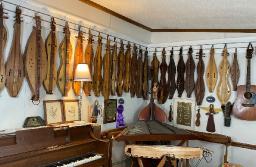Playing with hand issues
General mountain dulcimer or music discussions
Was just now on Reddit and had a person pop up in the Mountain Dulcimer community there with questions about playing the Mountain Dulcimer with health issues in his hands that he’s working on a diagnosis for. I wanted to share the answer I gave him here, and would welcome any other insight folks might have for future reference:
” I’ve got some kind of general connective tissue disorder that runs in my family that resembles hypermobile Ehlers-Danlos syndrome but comes with a side of Dupuytren’s contracture, which I have in my right hand, so far not in my left but I suspect it will arrive eventually. I also have congenital MCP joint lock in the thumbs of both hands. So, my hands have reduced strength and flexibility all around and yet dulcimer is a dream instrument because it matches my ergonomic needs better than any other instrument I’ve tried. Some info I’ve figured out as a still beginner player:
Picking/strumming hand: I’ve got a whole collection of different picks as I’ve tried to find what works for me, as my hand flexibility decreases over time. I find I like a pick with good flexibility as it compensates for my lack of same. Dunlop nylon .46 mm are my go-to for flat picking, but they might be too small for some folks. Blue Mountain blue thumb picks for finger picking are great, and I’ve been playing around a bit with Oud picks for fast strumming, which isn’t something I do much of, as their length and flexibility makes for less hand/wrist strain for me.
Chord/noter hand: Set up of the instrument is key. I had a previous dulcimer with high action, among other problems, and it was a complete life changer when I got a dulcimer with lower, easier action. Depending on your playing style you might find a three string (no doubled melody string) easier to manage. VSL is also key - don’t overstrain your hands by trying to play an instrument that’s VSL is just too long. My dulcimer at the moment has doubled strings and it’s VSL is a little too long for me to chord easily so it’s going to be my noter/drone dulcimer and I’ll be getting a New Harmony Pudge Pro soon, which has the VSL and three string setup I need, on the advice of my dulcimer teacher.
Hope this helps!”

 Instead of high to low, dAD, use low to high, DAd, it is more conventional for MD. For the other part of your question, always pluck the string just before turning the knob on the tuner. That way you know when you tune in the correct direction. As far as the F# A d, that would require a string change. You may be thinking of DF#A which needs different strings also. If you are tuned to DAA, just tune down, loosen, the middle string to F#.
Instead of high to low, dAD, use low to high, DAd, it is more conventional for MD. For the other part of your question, always pluck the string just before turning the knob on the tuner. That way you know when you tune in the correct direction. As far as the F# A d, that would require a string change. You may be thinking of DF#A which needs different strings also. If you are tuned to DAA, just tune down, loosen, the middle string to F#.
